Optical Amplifiers for Access and Passive Optical Networks: A Tutorial
Abstract
:1. Introduction
2. 3R—Reamplification, Reshaping, and Retiming
- Data-driven 3R regenerator—nonlinear optical gate. This scheme mainly consists of an optical amplifier, that is, a clock recovery block providing an unjittered short pulse clock stream, which is then modulated by a data-driven nonlinear optical gate block [50].
- Synchronous modulation 3R regenerator—this technique is particularly efficient with pure soliton pulses. It consists of combining the effects of a localized “clock-driven” synchronous modulation of data, filtering, and line fiber nonlinearity, which results in both timing jitter reduction and amplitude stabilization (see Figure 4). The high-dispersion fiber first converts the amplified pulse into a pure soliton. The filter blocks the unwanted ASE but also has an important role in stabilizing the amplitude in the regeneration span. Data are then synchronously and sinusoidally modulated through an intensity or phase modulator, driven by the recovered clock [50].
3. Optical Amplifiers in Telecommunications Networks
- gain—ratio of output and input power,
- gain waveform—should be flat in an ideal case,
- saturation power—capability to absorb high input power,
- saturation gain—energetic efficiency of the optical amplifier,
- insertion loss and insertion loss of the switch-off amplifier,
- bandwidth,
- noise figure—signal-to-noise ratio,
- temperature stability.
3.1. Erbium-Doped Fiber Amplifiers
- Optical radiation from the laser pump is coupled to an Er fiber with a length of a few meters (10–100 m).
- Due to this process, the atoms of erbium (Er ions) are excited.
- Absorbed energy allows migration to higher energetic layer E3.
- Ions in this so-called metastable state remain only for a short time (a few milliseconds).
- Then, the atoms migrate to the conductivity layer—E2 (nonradiative transition).
- After the state of “population inversion” is achieved, the highest proportion of Er ions is in an excited state, and the energy is released via the transmitted signal.
- The excited ions return to the basic energy layer E1 in the valence band. This is accompanied by the stimulated emission of radiation with the same wavelength and phase as the transmitted signal.
- This is how to temporally store the energy achieved by the laser pump.
- full optical system,
- high gain, 30–50 dB,
- low noise Figure (4–6 dB),
- polarization independent,
- the same phase and frequency as an input signal,
- high power transfer efficiency from pump to signal power (50%),
- can act as a shutter—when the EDFA is unpumped (e.g., if the electricity fails), it acts as shutter,
- large dynamic range,
- directly and simultaneously amplify a wide wavelength band (80 nm) in the 1550 nm region, with a relatively flat gain,
- flatness can be improved by gain-flattening optical filters,
- suitable for long-haul applications.
- Amplified spontaneous emission, there is always some output even with no signal input due to some de-excitation of ions in the fiber—spontaneous noise.
- necessary to use flat-top filters for WDM systems,
- not possible to use for the O-band,
- problematic miniaturization,
- inability to be integrated with other semiconductor devices,
- gain saturation effects.
3.2. Semiconductor Optical Amplifiers—SOAs
- Stimulated absorption.
- Media excitation. Excitation of a semiconductor medium in the P-N transition is the result of energy pumping and depends on stimulated absorption. Absorbed energy is transferred to an electron in the valence band, which is excited to a higher energetic layer in the valence band. The energy of an incident photon must be sufficient to overcome the forbidden band of the semiconductor.
- Population inversion. In a pro-polarized P-N transition, it is possible to achieve population inversion by molecular excitation to a higher energetic layer. The state of population inversion means that the quantity of electrons in the valence band is higher than the quantity of electrons in lower-energy bands.
- Gain generation. New photons are released. The resonator is reduced in comparison with semiconductor lasers. The newly generated photon stimulates recombination of electrons and holes. The result of this recombination is the generation of coherent photons with the same wavelength, polarization and phase as the incident photon.
- Leaving the edge of the chip. Stimulated emission is dependent on the intensity of the incident radiation.
- large range of wavelengths 1280–1600 nm,
- large bandwidth,
- maximal gain up to 30 dB,
- small size, possibility for integration on chips with lasers and semiconductor components,
- appropriate for all-optical systems,
- no optical pump is needed (electrically pumped),
- very good gain dynamics in comparison with fiber amplifiers,
- low cost,
- suitable for PONs.
- high insertion loss of the SOA amplifier (approximately 5 dB), which increases if the amplifier is switched off,
- low gain in commercial amplifiers (15–25 dB),
- residual polarization sensitivity,
- higher noise figure and cross-talk levels due to nonlinear phenomena such as 4-wave mixing (7–12 dB),
- requires temperature stabilization,
- cross-gain modulation of multiple signals via carrier depletion.
3.3. Raman Amplifiers
- Distributed Raman amplifier (DRA),
- Lumped Raman amplifier (LRA).
- high gain and saturation power,
- compatible with installed SM fibers,
- usable on any wavelength in telecommunication bands,
- low noise figure in comparison with those of SOAs and EDFAs,
- wavelength conversion,
- large transmission capacitance,
- able to be used to extend EDFAs.
- high pump power requirements,
- lower efficiency for a specific wavelength then EDFAs (for the same pump power),
- sophisticated gain control is needed.
3.4. Brillouin Amplification
- high gain and saturation power for narrowband signals,
- wavelength conversion,
- can enable amplification of a very small input signal (a few nanowatts) by more than 50 dB in a single gain step.
- limited range of use,
- nonlinear phenomena.
3.5. Amplifiers for PONs
- erbium-doped fiber amplifiers,
- thulium (1490 nm downstream) and praseodymium (1310 nm upstream) fiber-doped amplifiers,
- semiconductor optical amplifiers,
- Raman amplifiers.
4. Conclusions
Author Contributions
Funding
Acknowledgments
Conflicts of Interest
Abbreviations
| ALS | Automatic laser shutdown |
| APC | Angled physical contact |
| ASE | Amplified spontaneous emission |
| ATM | Asynchronous transfer mode |
| CESNET | Czech Education and Scientific Network |
| CD | Chromatic dispersion |
| CO | Central office |
| CW | Continuous wave |
| CWDM | Coarse wavelength division multiplexing |
| DCF | Dispersion compensating fiber |
| DRA | Distributed Raman amplifier |
| DRS | Distributed Rayleigh scattering |
| DSP | Digital signal processing |
| DWDM | Dense wavelength division multiplexing |
| EDFA | Erbium-doped fiber amplifier |
| FDDI | Fiber distributed data interface |
| FEC | Forward error correction |
| FTTx | Fiber to the x |
| GE | Gigabit Ethernet |
| GEPON | Gigabit Ethernet passive optical network |
| GPON | Gigabit passive optical network |
| GVP | Group velocity dispersion |
| IEEE | Institute of Electrical and Electronics Engineers |
| IST | Information Society Technologies |
| ITU | International Telecommunication Union |
| LAN | Local area network |
| LRA | Lumped Raman amplifier |
| MFD | Mode field diameter |
| NF | Noise figure |
| NGA | Next-generation access |
| NICs | Network interface controllers |
| OADM | Optical add-drop multiplexer |
| ODN | Optical distribution network |
| OEO | Optical electrical optical |
| OLT | Optical line terminal |
| ONU | Optical network unit |
| OOO | All-optical |
| OSNR | Optical signal-to-noise ratio |
| P2MP | Point-to-multipoint |
| PDFFAs | Praseodymium-doped fluoride fiber amplifiers |
| PIEMAN | Photonic integrated extended metro and access network |
| PMD | Polarization mode dispersion |
| RE-PON | Reach extended passive optical network |
| RF | Radio frequency |
| RN | Remote node |
| RSOA | Reconfigurable semiconductor optical amplifier |
| SARDANA | Scalable advanced ring dense access network architecture |
| SNR | Signal-to-noise ratio |
| SBS | Stimulated Brillouin scattering |
| SOA | Semiconductor optical amplifier |
| SRS | Stimulated Raman inelastic scattering |
| TAT | Trans-Atlantic transmission |
| TW | Traveling wave |
| WDM | Wavelength division multiplexing |
| WDM-TDM LR-PON | Wavelength and time-division multiplexing long-reach passive optical network |
| WWW | World Wide Web |
References
- Ford, G.S. Is faster better? Quantifying the relationship between broadband speed and economic growth. Telecommun. Policy 2018, 42, 766–777. [Google Scholar] [CrossRef]
- Hernandez, J.A.; Sanchez, R.; Martin, I.; Larrabeiti, D. Meeting the Traffic Requirements of Residential Users in the Next Decade with Current FTTH Standards. IEEE Commun. Mag. 2019, 57, 120–125. [Google Scholar] [CrossRef]
- Harstead, E.; Bonk, R.; Walklin, S.; van Veen, D.; Houtsma, V.; Kaneda, N.; Mahadevan, A.; Borkowski, R. From 25 Gb/s to 50 Gb/s TDM PON. J. Opt. Commun. Netw. 2020, 12, D17–D26. [Google Scholar] [CrossRef]
- Kani, J.-i.; Terada, J.; Hatano, T.; Kim, S.Y.; Asaka, K.; Yamada, T. Future optical access network enabled by modularization and softwarization of access and transmission functions [Invited]. J. Opt. Commun. Netw. 2020, 12, D48–D56. [Google Scholar] [CrossRef]
- DeSanti, C.; Du, L.; Guarin, J.; Bone, J.; Lam, C.F. Super-PON. J. Opt. Commun. Netw. 2020, 12, D66–D77. [Google Scholar] [CrossRef]
- Zhang, D.; Liu, D.; Wu, X.; Nesset, D. Progress of ITU-T higher speed passive optical network (50G-PON) standardization. J. Opt. Commun. Netw. 2020, 12, D99–D108. [Google Scholar] [CrossRef]
- Arpanaei, F.; Ardalani, N.; Beyranvand, H.; Shariati, B. QoT-aware performance evaluation of spectrally–spatially flexible optical networks over FM-MCFs. J. Opt. Commun. Netw. 2020, 12, 288–300. [Google Scholar] [CrossRef]
- Chen, J.; Wosinska, L.; Machuca, C.M.; Jaeger, M. Cost vs. reliability performance study of fiber access network architectures. IEEE Commun. Mag. 2010, 48, 56–65. [Google Scholar] [CrossRef]
- Zheng, X.Y.; He, M.J. Research and Implementation of Key Technologies in FTTH Networks Combining. Procedia Comput. Sci. 2019, 154, 439–445. [Google Scholar] [CrossRef]
- Jay, S.; Neumann, K.H.; Plückebaum, T. Comparing FTTH access networks based on P2P and PMP fibre topologies. Telecommun. Policy 2014, 38, 415–425. [Google Scholar] [CrossRef]
- Schneir, J.R.; Xiong, Y. Economic implications of a co-investment scheme for FTTH/PON architectures. Telecommun. Policy 2013, 37, 849–860. [Google Scholar] [CrossRef]
- Khalili, H.; Rincón, D.; Sallent, S.; Piney, J.R. An Energy-Efficient Distributed Dynamic Bandwidth Allocation Algorithm for Passive Optical Access Networks. Sustainability 2020, 12, 2264. [Google Scholar] [CrossRef] [Green Version]
- Memon, K.; Mohammadani, K.; Ain, N.; Shaikh, A.; Ullah, S.; Zhang, Q.; Das, B.; Ullah, R.; Tian, F.; Xin, X. Demand Forecasting DBA Algorithm for Reducing Packet Delay with Efficient Bandwidth Allocation in XG-PON. Electronics 2019, 8, 147. [Google Scholar] [CrossRef] [Green Version]
- G.984.6: Gigabit-Capable Passive Optical Networks (GPON): Reach Extension; International Telecommunication Union (ITU): Geneva, Switzerland, 2008.
- G.987.4: 10-Gigabit-Capable Passive Optical Networks (XG-PON): Reach Extension; International Telecommunication Union (ITU): Geneva, Switzerland, 2012.
- G.9807.2: 10 Gigabit-Capable Passive Optical Networks (XG(S)-PON): Reach Extension; International Telecommunication Union (ITU): Geneva, Switzerland, 2017.
- IEEE P802.3ah Ethernet in the First Mile Task Force; Institute of Electrical and Electronics Engineers (IEEE): Piscataway, NJ, USA, 2004.
- 802.3bk-2013—IEEE Standard for Ethernet—Amendment 1: Physical Layer Specifications and Management Parameters for Extended Ethernet Passive Optical Networks; Institute of Electrical and Electronics Engineers (IEEE): Piscataway, NJ, USA, 2013.
- P802.3cs—Standard for Ethernet Amendment: Physical Layers and Management Parameters for Increased-Reach Point-to-Multipoint Ethernet Optical Subscriber Access (Super-PON); Institute of Electrical and Electronics Engineers (IEEE): Piscataway, NJ, USA, 2018.
- Du, L.B.; Zhao, X.; Yin, S.; Zhang, T.; Barratt, A.E.T.; Jiang, J.; Wang, D.; Geng, J.; DeSanti, C.; Lam, C.F. Long-Reach Wavelength-Routed TWDM PON. J. Light. Technol. 2019, 37, 688–697. [Google Scholar] [CrossRef]
- Fujiwara, M.; Koma, R. Long-Reach and High-Splitting-Ratio WDM/TDM-PON Systems Using Burst-Mode Automatic Gain Controlled SOAs. J. Light. Technol. 2016, 34, 901–909. [Google Scholar] [CrossRef]
- Zhang, Z.; Chen, X.; Wang, L.; Zhang, M. 40-Gb/s QPSK downstream and 10-Gb/s RSOA-based upstream transmission in long-reach WDM PON employing remotely pumped EDFA and FBG optical equalizer. In Proceedings of the 2013 8th International Conference on Communications and Networking in China (CHINACOM), Guilin, China, 14–16 August 2013; pp. 788–791. [Google Scholar] [CrossRef]
- Alves, T.M.F.; Morant, M.; Cartaxo, A.V.T.; Llorente, R. Design of Directly Modulated Long-Reach PONs Reaching 125 km for Provisioning of Hybrid Wired–Wireless Quintuple-Play Service. J. Opt. Commun. Netw. 2013, 5, 848–857. [Google Scholar] [CrossRef]
- Contestabile, G.; Bontempi, F. All-Optical Distribution Node for Long Reach PON Downlink. IEEE Photonics Technol. Lett. 2014, 26, 1403–1406. [Google Scholar] [CrossRef]
- Taguchi, K.; Asaka, K.; Fujiwara, M.; Kaneko, S.; Yoshida, T.; Fujita, Y.; Iwamura, H.; Kashima, M.; Furusawa, S.; Sarashina, M.; et al. Field Trial of Long-Reach and High-Splitting λ-Tunable TWDM-PON. J. Light. Technol. 2016, 34, 213–221. [Google Scholar] [CrossRef]
- Chen, H.Y.; Wei, C.C.; Lu, I.C.; Chu, H.H.; Chen, Y.C.; Chen, J. High-Capacity and High-Loss-Budget OFDM Long-Reach PON Without an Optical Amplifier [Invited]. J. Opt. Commun. Netw. 2015, 7, A59–A65. [Google Scholar] [CrossRef]
- Saliou, F.; Chanclou, P.; Laurent, F.; Genay, N.; Lazaro, J.A.; Bonada, F.; Prat, J. Reach Extension Strategies for Passive Optical Networks [Invited]. J. Opt. Commun. Netw. 2009, 1, C51–C60. [Google Scholar] [CrossRef]
- Nesset, D.; Appathurai, S.; Davey, R.; Kelly, T. Extended Reach GPON Using High Gain Semiconductor Optical Amplifiers. In Proceedings of the OFC/NFOEC 2008—2008 Conference on Optical Fiber Communication/National Fiber Optic Engineers Conference, San Diego, CA, USA, 24–28 February 2008; pp. 1–3. [Google Scholar] [CrossRef]
- Nesset, D.; Wright, P. Raman Extended GPON using 1240 nm Semiconductor Quantum-Dot Lasers. In Proceedings of the Optical Fiber Communication Conference, San Diego, CA, USA, 21–25 March 2010; OSA: San Diego, CA, USA, 2010; pp. 1–3. [Google Scholar] [CrossRef]
- Nesset, D.; Farrow, K.; Wright, P. Bidirectional, Raman extended GPON with 50 km reach and 1:64 split using wavelength stabilised pumps. In Proceedings of the 2011 37th European Conference and Exhibition on Optical Communication, Geneva, Switzerland, 18–22 September 2011; pp. 1–3. [Google Scholar]
- Genay, N.; Soret, T.; Chanclou, P.; Landousies, B.; Guillo, L.; Saliou, F. Evaluation of the Budget Extension of a GPON by EDFA Amplification. In Proceedings of the 2007 9th International Conference on Transparent Optical Networks, Rome, Italy, 1–5 July 2007; pp. 76–79. [Google Scholar] [CrossRef]
- Antony, C.; Talli, G.; Santa, M.D.; Murray, B.; Hegarty, S.; Kehayas, E.; Krestnikov, I.; Townsend, P.D. XG-PON Raman reach extender based on quantum dot lasers. In Proceedings of the 2014 the European Conference on Optical Communication (ECOC), Cannes, France, 21–25 September 2014; pp. 1–3. [Google Scholar] [CrossRef]
- Payne, D. Kilowatt Fibre Lasers and Beyond. In Proceedings of the 2006 IET Seminar on High Power Diode Pumped Lasers and Systems, London, UK, 5 December 2006; pp. 65–83. [Google Scholar]
- Desurvire, E.B. Capacity Demand and Technology Challenges for Lightwave Systems in the Next Two Decades. J. Light. Technol. 2006, 24, 4697–4710. [Google Scholar] [CrossRef]
- Wagner, S. Correction to “Optical Amplifier Applications in Fiber Optic Local Networks”. IEEE Trans. Commun. 1987, 35, 854. [Google Scholar] [CrossRef]
- Henry, C. Theory of spontaneous emission noise in open resonators and its application to lasers and optical amplifiers. J. Light. Technol. 1986, 4, 288–297. [Google Scholar] [CrossRef]
- Loudon, R. Theory of noise accumulation in linear optical-amplifier chains. IEEE J. Quantum Electron. 1985, 21, 766–773. [Google Scholar] [CrossRef]
- Henning, I.; Adams, M.; Collins, J. Performance predictions from a new optical amplifier model. IEEE J. Quantum Electron. 1985, 21, 609–613. [Google Scholar] [CrossRef]
- Fye, D. Practical limitations on optical amplifier performance. J. Light. Technol. 1984, 2, 403–406. [Google Scholar] [CrossRef]
- Faulkner, D. A wide-band limiting amplifier for optical fiber repeaters. IEEE J. Solid-State Circuits 1983, 18, 333–340. [Google Scholar] [CrossRef]
- Massey, G.; Johnson, J. Gain limitations in optical parametric amplifiers. IEEE J. Quantum Electron. 1979, 15, 201–203. [Google Scholar] [CrossRef]
- Hullett, J.; Muoi, T. A Feedback Receive Amplifier for Optical Transmission Systems. IEEE Trans. Commun. 1976, 24, 1180–1185. [Google Scholar] [CrossRef]
- Qiu, X.Z.; Yin, X.; Verbrugghe, J.; Moeneclaey, B.; Vyncke, A.; Praet, C.V.; Torfs, G.; Bauwelinck, J.; Vandewege, J. Fast Synchronization 3R Burst-Mode Receivers for Passive Optical Networks. J. Light. Technol. 2014, 32, 644–659. [Google Scholar] [CrossRef] [Green Version]
- Nakagawa, J.; Nogami, M.; Suzuki, N.; Noda, M.; Yoshima, S.; Tagami, H. 10.3-Gb/s Burst-Mode 3R Receiver Incorporating Full AGC Optical Receiver and 82.5-GS/s Over-Sampling CDR for 10G-EPON Systems. IEEE Photonics Technol. Lett. 2010, 22, 471–473. [Google Scholar] [CrossRef]
- Tran, N.C.; Bauwelinck, J.; Yin, X.; Tangdiongga, E.; Koonen, T. Demonstration of Long-Reach PON Using 10 Gb/s 3R Burst-Mode Wavelength Converter. IEEE Photonics Technol. Lett. 2013, 25, 1492–1495. [Google Scholar] [CrossRef] [Green Version]
- Nakagawa, J.; Noda, M.; Suzuki, N.; Yoshima, S.; Nakura, K.; Nogami, M. Demonstration of 10G-EPON and GE-PON Coexisting System Employing Dual-Rate Burst-Mode 3R Transceiver. IEEE Photonics Technol. Lett. 2010, 22, 1841–1843. [Google Scholar] [CrossRef]
- Nishihara, S.; Kimura, S.; Yoshida, T.; Nakamura, M.; Terada, J.; Nishimura, K.; Kishine, K.; Kato, K.; Ohtomo, Y.; Yoshimoto, N.; et al. A Burst-Mode 3R Receiver for 10-Gbit/s PON Systems With High Sensitivity, Wide Dynamic Range, and Fast Response. J. Light. Technol. 2008, 26, 99–107. [Google Scholar] [CrossRef]
- Kim, K.O.; Doo, K.H.; Lee, S.S. Design of a Hybrid PON System for GPON Reach Extension on the Basis of Colorless DWDM-PON and 3R Regenerator. In Proceedings of the 2010 IEEE Global Telecommunications Conference GLOBECOM 2010, Miami, FL, USA, 6–10 December 2010; pp. 1–4. [Google Scholar] [CrossRef]
- Umeda, D.; Ikagawa, T.; Yamazaki, K.; Hirakata, N.; Yamagishi, K. Bidirectional 3R Repeater for GE-PON Systems. In Proceedings of the 2006 European Conference on Optical Communications, Cannes, France, 24–28 September 2006; pp. 1–2. [Google Scholar] [CrossRef]
- Simon, J.C.; Bramerie, L.; Ginovart, F.; Roncin, V.; Gay, M.; Feve, S.; le Cren, E.; Chares, M.L. All-optical regeneration techniques. Ann. Telecommun. 2003, 11, 1708–1724. [Google Scholar] [CrossRef]
- Izawa, T.; Sudo, S. Optical Fibers; Kluwer Academic Publishers: Norwell, MA, USA, 1987. [Google Scholar]
- Crisp, J.; Elliott, B.J. Introduction to Fiber Optics, 3rd ed.; Newnes: Boston, MA, USA, 2005. [Google Scholar]
- Singh, M. Electronic Dispersion Compensation in Optical Fiber Communication, 1st ed.; LAP LAMBERT Academic Publishing: Saarbrucken, Germany, 2016. [Google Scholar]
- Ramaswami, R.; Sivarajan, K.N.; Sasaki, G.H. Optical Networks, 3rd ed.; Elsevier/Morgan Kaufmann: Boston, MA, USA, 2010. [Google Scholar]
- Menyuk, C.R.; Galtarossa, A. Polarization Mode Dispersion, 1st ed.; Springer: New York, NY, USA, 2005. [Google Scholar]
- Meghanathan, N.; Boumerdassi, S.; Chaki, N.; Nagamalai, D. Recent Trends in Networks and Communications: International Conferences, NeCoM 2010, WiMoN 2010, WeST 2010, Chennai, India, 23–25 July 2010; Springer: Berlin/Heidelberg, Germany, 2010; pp. 1–721. [Google Scholar] [CrossRef]
- Slavik, R.; Bogris, A.; Kakande, J.; Parmigiani, F.; Gruner-Nielsen, L.; Phelan, R.; Vojtech, J.; Petropoulos, P. Field-Trial of an All-Optical PSK Regenerator/Multicaster in a 40 Gbit/s, 38 Channel DWDM Transmission Experiment. J. Light. Technol. 2012, 30, 512–520. [Google Scholar] [CrossRef] [Green Version]
- Simatupang, J.W.; Lee, S.-L. Theoretical and simulation analysis on potential impairments in bidirectional WDM-PONs. In Proceedings of the IEEE 3rd International Conference on Photonics, Penang, Malaysia, 1–3 October 2012; pp. 61–65. [Google Scholar] [CrossRef]
- Kaminow, I.; Li, T. Optical Fiber Telecommunications IV-B, 4th ed.; Academic Press: New York, NY, USA, 2002; Volume B. [Google Scholar]
- Agrawal, G.P. Fiber-Optic Communication Systems, 4th ed.; Wiley: New York, NY, USA, 2010. [Google Scholar]
- Senior, J.M.; Jamro, M.Y. Optical Fiber Communications, 3rd ed.; Financial Times/Prentice Hall: New York, NY, USA, 2009. [Google Scholar]
- Digonnet, M.J.F. Rare-Earth-Doped Fiber Lasers and Amplifiers, Revised and Expanded 2nd ed.; Marcel Dekker: New York, NY, USA, 2001. [Google Scholar]
- Gowan, B. Coherent Optical Turns 10: Here-s How It Was Made. Available online: https://www.ciena.com/insights/articles/Coherent-optical-turns-10-Heres-how-it-was-made-prx.html (accessed on 25 August 2020).
- Marhic, M.E. Fiber Optical Parametric Amplifiers, Oscillators and Related Devices, 1st ed.; Cambridge University Press: Cambridge, UK, 2007. [Google Scholar]
- Becker, P.C.; Olsson, N.A.; Simpson, J.R. Erbium-Doped Fiber Amplifiers: Fundamentals and Technology (Optics and Photonics), 1st ed.; Academic Press: New York, NY, USA, 1999. [Google Scholar]
- Desurvire, E. Erbium-Doped Fiber Amplifiers; Wiley: New York, NY, USA, 1994. [Google Scholar]
- Vojtech, J.; Karasek, M.; Radil, J. Extending the reach of 10GE at 1310 nm. In Proceedings of the 2005 7th International Conference Transparent Optical Networks, Barcelona, Catalonia, Spain, 7 July 2005; pp. 39–42. [Google Scholar] [CrossRef]
- Dutta, N.K.; Wang, Q. Semiconductor Optical Amplifiers, 2nd ed.; World Scientific Publishing: Hackensack, NJ, USA, 2006. [Google Scholar]
- Vojtech, J.; Radil, J.; Smotlacha, V. Semiconductor Optical Amplifier with Holding Beam Injection for Single Path Accurate Time Transmission. In Proceedings of the CLEO: 2015, San Jose, CA, USA, 10–15 May 2015; OSA: Washington, DC, USA, 2015. [Google Scholar] [CrossRef]
- Raman, C. A new radiation. Indian J. Phys. 1928, 2, 387–398. [Google Scholar] [CrossRef]
- Ghatak, A.; Thyagarajan, K. An Introduction to Fiber Optics, 1st ed.; Cambridge University Press: Cambridge, UK, 1998. [Google Scholar]
- Munster, P.; Vojtech, J.; Sysel, P.; Sifta, R.; Novotny, V.; Horvath, T.; Sima, S.; Filka, M. Φ-OTDR signal amplification. In Proceedings of the Optical Sensors 2015. International Society for Optics and Photonics, SPIE 2015, Prague, Czech Republic, 13–16 April 2015; Volume 9506, pp. 28–36. [Google Scholar] [CrossRef]
- Yasin, M. Advances in Optical Fiber Technology, 1st ed.; InTech Open: London, UK, 2015. [Google Scholar]
- Terra, O.; Grosche, G.; Schnatz, H. Brillouin amplification in phase coherent transfer of optical frequencies over 480 km fiber. Opt. Express 2010, 18, 16102–16111. [Google Scholar] [CrossRef] [Green Version]
- Predehl, K.; Grosche, G.; Raupach, S.M.F.; Droste, S.; Terra, O.; Alnis, J.; Legero, T.; Hansch, T.W.; Udem, T.; Holzwarth, R.; et al. A 920-Kilometer Optical Fiber Link for Frequency Metrology at the 19th Decimal Place. Science 2012, 336, 441–444. [Google Scholar] [CrossRef]
- Davey, R.; Kani, J.; Bourgart, F.; McCammon, K. Options for future optical access networks. IEEE Commun. Mag. 2006, 44, 50–56. [Google Scholar] [CrossRef]
- Nesset, D. 10 Gbit/s bidirectional transmission in 1024-way split, 110 km reach, PON system using commercial transceiver modules, super FEC and EDC. In Proceedings of the 31st European Conference on Optical Communications (ECOC 2005), Glasgow, UK, 25–29 September 2005; pp. 135–138. [Google Scholar] [CrossRef] [Green Version]
- Lee, K.L.; Riding, J.L.; Tran, A.V.; Tucker, R.S. Extended reach gigabit passive optical networks for rural areas using Raman and semiconductor optical amplifiers. In Proceedings of the 2009 14th OptoElectronics and Communications Conference, Vienna, Austria, 13–17 July 2009; pp. 1–2. [Google Scholar] [CrossRef]
- Shea, D.; Mitchell, J. Long-Reach Optical Access Technologies. IEEE Netw. 2007, 21, 5–11. [Google Scholar] [CrossRef]
- Talli, G.; Townsend, P. Hybrid DWDM-TDM long-reach PON for next-generation optical access. J. Light. Technol. 2006, 24, 2827–2834. [Google Scholar] [CrossRef]
- Talli, G.; Chow, C.W.; Townsend, P.; Davey, R.; Ridder, T.D.; Qiu, X.Z.; Ossieur, P.; Krimmel, H.G.; Smith, D.; Lealman, I.; et al. Integrated Metro and Access Networks: PIEMAN. In Proceedings of the 12th European Conference on Networks and Optical Communications—NOC 2007, Stockholm, Sweden, 18–21 June 2007; pp. 493–500. [Google Scholar]
- Yoo, J.J.; Yun, H.H.; Kim, T.Y.; Lee, K.B.; Park, M.Y.; Kim, B.W.; Kim, B.T. A WDM-Ethernet hybrid passive optical network architecture. In Proceedings of the 2006 8th International Conference Advanced Communication Technology, Phoenix Park, Korea, 20–22 February 2006; pp. 1754–1757. [Google Scholar] [CrossRef]
- Lazaro, J.A.; Prat, J.; Chanclou, P.; Beleffi, G.M.T.; Teixeira, A.; Tomkos, I.; Soila, R.; Koratzinos, V. Scalable Extended Reach PON. In Proceedings of the OFC/NFOEC 2008—2008 Conference on Optical Fiber Communication/National Fiber Optic Engineers Conference, San Diego, CA, USA, 24–28 February 2008; pp. 1–3. [Google Scholar] [CrossRef]
- Lazaro, J.A.; Polo, V.; Bock, C.; Omella, M.; Prat, J. Remotely Amplified SARDANA. In Proceedings of the 2006 European Conference on Optical Communications, Cannes, France, 24–28 September 2006; pp. 1–2. [Google Scholar] [CrossRef]
- Prat, J.; Lazaro, J.; Chanclou, P.; Soila, R.; Gallardo, A.M.; Teixeira, A.; TosiBeleffi, G.M.; Tomkos, I. Results from EU Project SARDANA on 10G extended reach WDM PONs. In Proceedings of the 2010 Conference on Optical Fiber Communication (OFC/NFOEC), Collocated National Fiber Optic Engineers Conference, San Diego, CA, USA, 21–25 March 2010; pp. 1258–1260. [Google Scholar] [CrossRef]
- Smolorz, S.; Rohde, H.; Ossieur, P.; Antony, C.; Townsend, P.D.; Ridder, T.D.; Baekelandt, B.; Qiu, X.Z.; Appathurai, S.; Krimmel, H.G.; et al. Next generation access networks. In Proceedings of the 2009 International Conference on Photonics in Switching, Pisa, Italy, 15–19 September 2009; pp. 1–4. [Google Scholar] [CrossRef]
- Lee, J.H.; Cho, S.H.; Lee, H.H.; Jung, E.S.; Yu, J.H.; Kim, B.W.; Lee, S.H.; Koh, J.S.; Sung, B.H.; Kang, S.J.; et al. First Commercial Deployment of a Colorless Gigabit WDM/TDM Hybrid PON System Using Remote Protocol Terminator. J. Light. Technol. 2010, 28, 344–351. [Google Scholar] [CrossRef]
- An, F.T.; Kim, K.; Gutierrez, D.; Yam, S.; Hu, E.; Shrikhande, K.; Kazovsky, L. SUCCESS. J. Light. Technol. 2004, 22, 2557–2569. [Google Scholar] [CrossRef]
- Cao, Y.; Gan, C.; Zhou, Y.; Shi, L.; Zhu, L. A novel architecture of reconfigurable WDM/TDM-PON. In Proceedings of the 19th Annual Wireless and Optical Communications Conference (WOCC 2010), Shanghai, China, 14–15 May 2010; pp. 1–4. [Google Scholar] [CrossRef]
- Oakley, K.; Jensen, J.; Walkoe, W. British Telecom TPON application in the US network. In Proceedings of the 1989 IEEE Global Telecommunications Conference and Exhibition ‘Communications Technology for the 1990s and Beyond’, Dallas, TX, USA, 27–30 November 1989; pp. 1340–1345. [Google Scholar] [CrossRef]
- Hawker, I.; Whitt, S.; Bennett, G. The future British Telecom core transmission network. In Proceedings of the Second IEE National Conference on Telecommunications 1989, York, UK, 2–5 April 1989; pp. 364–368. [Google Scholar]
- Van Deventer, M.O.; van Dam, Y.; Peters, P.; Vermaerke, F.; Phillips, A. Evolution phases to an ultra broadband access network. IEEE Commun. Mag. 1997, 35, 72–77. [Google Scholar] [CrossRef]
- Tkach, R.; Chraplyvy, A.; Derosier, R. Performance of a WDM network based on stimulated Brillouin scattering. IEEE Photonics Technol. Lett. 1989, 1, 111–113. [Google Scholar] [CrossRef]
- Leng, L.; Le, T. All-optical carrier regeneration at optical network unit using a Brillouin/Erbium fiber laser. In Proceedings of the 2008 International Conference on Photonics in Switching, Sapporo, Japan, 4–7 August 2008; pp. 1–2. [Google Scholar] [CrossRef]
- Kim, D.; Kim, B.G.; Bo, T.; Kim, H. Performance Improvement of RSOA-based Coherent WDM PON Using SBS Suppression and Erasing Frequency-Dithering Tone. In Proceedings of the 2018 23rd Opto-Electronics and Communications Conference (OECC), Jeju Island, Korea, 2–6 July 2018; pp. 1–2. [Google Scholar] [CrossRef]
- Lalam, N.; Ng, W.P.; Dai, X.; Wu, Q.; Fu, Y. Sensing range improvement of brillouin optical time domain reflectometry (BOTDR) using inline erbium-doped fibre amplifier. In Proceedings of the 2017 IEEE SENSORS, Glasgow, UK, 29 October–1 November 2017; pp. 1–3. [Google Scholar] [CrossRef]
- Xing, L.; Zhan, L.; Luo, S.; Xia, Y. High-Power Low-Noise Fiber Brillouin Amplifier for Tunable Slow-Light Delay Buffer. IEEE J. Quantum Electron. 2008, 44, 1133–1138. [Google Scholar] [CrossRef]
- Noordegraaf, D.; Lorenzen, M.; Nielsen, C.V.; Rottwitt, K. Brillouin Scattering in Fiber Optical Parametric Amplifiers. In Proceedings of the 2007 9th International Conference on Transparent Optical Networks, Rome, Italy, 1–5 July 2007; pp. 197–200. [Google Scholar] [CrossRef]
- Yi, L.; Zhan, L.; Hu, W.; Hu, P.; Su, Y.; Leng, L.; Xia, Y. A highly stable low-RIN hybrid Brillouin/erbium amplified laser source. IEEE Photonics Technol. Lett. 2006, 18, 1028–1030. [Google Scholar] [CrossRef]
- Strutz, S.; Williams, K.; Esman, R. Polarization-maintaining hybrid erbium-Brillouin amplifier for high-power low-noise sources. IEEE Photonics Technol. Lett. 2001, 13, 936–938. [Google Scholar] [CrossRef]
- Vedadi, A.; Alasia, D.; Lantz, E.; Maillotte, H.; Thevenaz, L.; Gonzalez-Herraez, M.; Sylvestre, T. Brillouin Optical Time-Domain Analysis of Fiber-Optic Parametric Amplifiers. IEEE Photonics Technol. Lett. 2007, 19, 179–181. [Google Scholar] [CrossRef]
- Chen, L.; Yu, J.; Wen, S.; Lu, J.; Dong, Z.; Huang, M.; Chang, G. A Novel Scheme for Seamless Integration of ROF With Centralized Lightwave OFDM-WDM-PON System. J. Light. Technol. 2009, 27, 2786–2791. [Google Scholar] [CrossRef]
- Cao, Z.; Yu, J.; Zhou, H.; Wang, W.; Xia, M.; Wang, J.; Tang, Q.; Chen, L. WDM-RoF-PON Architecture for Flexible Wireless and Wire-Line Layout. J. Opt. Commun. Netw. 2010, 2, 117–121. [Google Scholar] [CrossRef]
- Miyamoto, K.; Tashiro, T.; Fukada, Y.; Kani, J.-i.; Terada, J.; Yoshimoto, N.; Iwakuni, T.; Higashino, T.; Tsukamoto, K.; Komaki, S.; et al. Transmission Performance Investigation of RF Signal in RoF-DAS Over WDM-PON With Bandpass-Sampling and Optical TDM. J. Light. Technol. 2013, 31, 3477–3488. [Google Scholar] [CrossRef]
- Liu, A.; Wang, X.; Shao, Q.; Song, T.; Yin, H.; Zhao, N. A low cost structure of radio-over-fiber system compatible with WDM-PON. In Proceedings of the 2016 25th Wireless and Optical Communication Conference (WOCC), Chengdu, China, 21–23 May 2016; pp. 1–3. [Google Scholar] [CrossRef]
- Ji, W.; Kang, Z. Design of WDM RoF PON Based on OFDM and Optical Heterodyne. J. Opt. Commun. Netw. 2013, 5, 652–657. [Google Scholar] [CrossRef]
- Ji, W.; Li, X.; Kang, Z.; Xue, X. Design of WDM-RoF-PON Based on Improved OFDM Mechanism and Optical Coherent Technology. J. Opt. Commun. Netw. 2015, 7, 74–82. [Google Scholar] [CrossRef]
- Fujiwara, M.; Suzuki, K.I.; Imai, T.; Taguchi, K.; Ishii, H.; Yoshimoto, N. ALC Burst-Mode Optical Fiber Amplifiers for 10 Gb/s-Class Long-Reach PONs. J. Opt. Commun. Netw. 2012, 4, 614–621. [Google Scholar] [CrossRef]
- Fukada, Y.; Suzuki, K.I.; Nakamura, H.; Yoshimoto, N.; Tsubokawa, M. First demonstration of fast automatic-gain-control (AGC) PDFA for amplifying burst-mode PON upstream signal. In Proceedings of the 2008 34th European Conference on Optical Communication, Brussels, Belgium, 21–25 September 2008; pp. 1–2. [Google Scholar] [CrossRef]
- Muro, R.D. Praseodymium-doped fibre amplifiers for WDM applications. In Proceedings of the IEEE Colloquium on WDM Technology and Applications, London, UK, 6 February 1997; p. 20. [Google Scholar] [CrossRef]
- Fake, M.; Stalley, K.; Cooke, R.; Whitley, T.; Kikushima, K.; Lawrence, E. Multichannel FM-TV transmission using an engineered 1.3 μm praseodymium-doped fluoride fibre amplifier. Electron. Lett. 1994, 30, 1431–1432. [Google Scholar] [CrossRef]
- Nishida, Y.; Yamada, M.; Kanamori, T.; Kobayashi, K.; Temmyo, J.; Sudo, S.; Ohishi, Y. Development of an efficient praseodymium-doped fiber amplifier. IEEE J. Quantum Electron. 1998, 34, 1332–1339. [Google Scholar] [CrossRef]
- Shi, J.; Tang, M.; Fu, S.; Shum, P. Modeling and analysis of visible praseodymium doped fiber lasers. In Proceedings of the 2012 17th Opto-Electronics and Communications Conference, Busan, Korea, 2–6 July 2012; pp. 375–376. [Google Scholar] [CrossRef]
- Sanders, S.; Dzurko, K.; Parke, R.; O’Brien, S.; Welch, D.; Grubb, S.; Nykolak, G.; Becker, P. Praseodymium doped fibre amplifiers (PDFAs) pumped by monolithic master oscillator power amplifier (M-MOPA) laser diodes. Electron. Lett. 1996, 32, 343–345. [Google Scholar] [CrossRef]
- Kjaer, R.; Monroy, I.T.; Oxenlowe, L.K.; Jeppesen, P.; Palsdottir, B. Impairments Due to Burst-Mode Transmission in a Raman-Based Long-Reach PON Link. IEEE Photonics Technol. Lett. 2007, 19, 1490–1492. [Google Scholar] [CrossRef] [Green Version]
- Amaral, G.C.; Herrera, L.E.Y.; Vitoreti, D.; Temporao, G.P.; Urban, P.J.; von der Weid, J.P. WDM-PON Monitoring With Tunable Photon Counting OTDR. IEEE Photonics Technol. Lett. 2014, 26, 1279–1282. [Google Scholar] [CrossRef]
- Peiris, S.; Madamopoulos, N.; Antoniades, N.; Richards, D.; Ummy, M.A.; Dorsinville, R. Engineering an Extended Gain Bandwidth Hybrid Raman—Optical Parametric Amplifier for Next Generation CWDM PON. J. Light. Technol. 2014, 32, 939–946. [Google Scholar] [CrossRef]
- Muciaccia, T.; Gargano, F.; Passaro, V. A TWDM-PON with Advanced Modulation Techniques and a Multi-Pump Raman Amplifier for Cost-Effective Migration to Future UDWDM-PONs. J. Light. Technol. 2015, 33, 2986–2996. [Google Scholar] [CrossRef]
- Acharya, K.K.; Raja, M.Y.A. Raman Amplified PON (RA-PON). In Proceedings of the 2008 International Symposium on High Capacity Optical Networks and Enabling Technologies, Penang, Malaysia, 18–20 November 2008; pp. 240–244. [Google Scholar] [CrossRef]
- Taguchi, K.; Asaka, K.; Kimura, S.; Suzuki, K.I.; Otaka, A. Reverse Bias Voltage Controlled Burst-Mode Booster SOA in λ-Tunable ONU Transmitter for High-Split-Number TWDM-PON. J. Opt. Commun. Netw. 2018, 10, 431–439. [Google Scholar] [CrossRef]
- Naughton, A.; Talli, G.; Porto, S.; Antony, C.; Ossieur, P.; Townsend, P.D. Design Optimization of R-EAM-SOA for Long-Reach Carrier-Distributed Passive Optical Networks. J. Light. Technol. 2014, 32, 4386–4392. [Google Scholar] [CrossRef]
- Saliou, F.; Chanclou, P.; Genay, N.; Lazaro, J.A.; Bonada, F.; Othmani, A.; Zhou, Y. Single SOA to extend simultaneously the optical budget of coexisting G-PON and 10G-PON. In Proceedings of the 36th European Conference and Exhibition on Optical Communication, Torino, Italy, 19–23 September 2010; pp. 1–3. [Google Scholar] [CrossRef]
- Guo, Q.; Tran, A.V. Demonstration of 40-Gb/s WDM-PON System Using SOA-REAM and Equalization. IEEE Photonics Technol. Lett. 2012, 24, 951–953. [Google Scholar] [CrossRef]
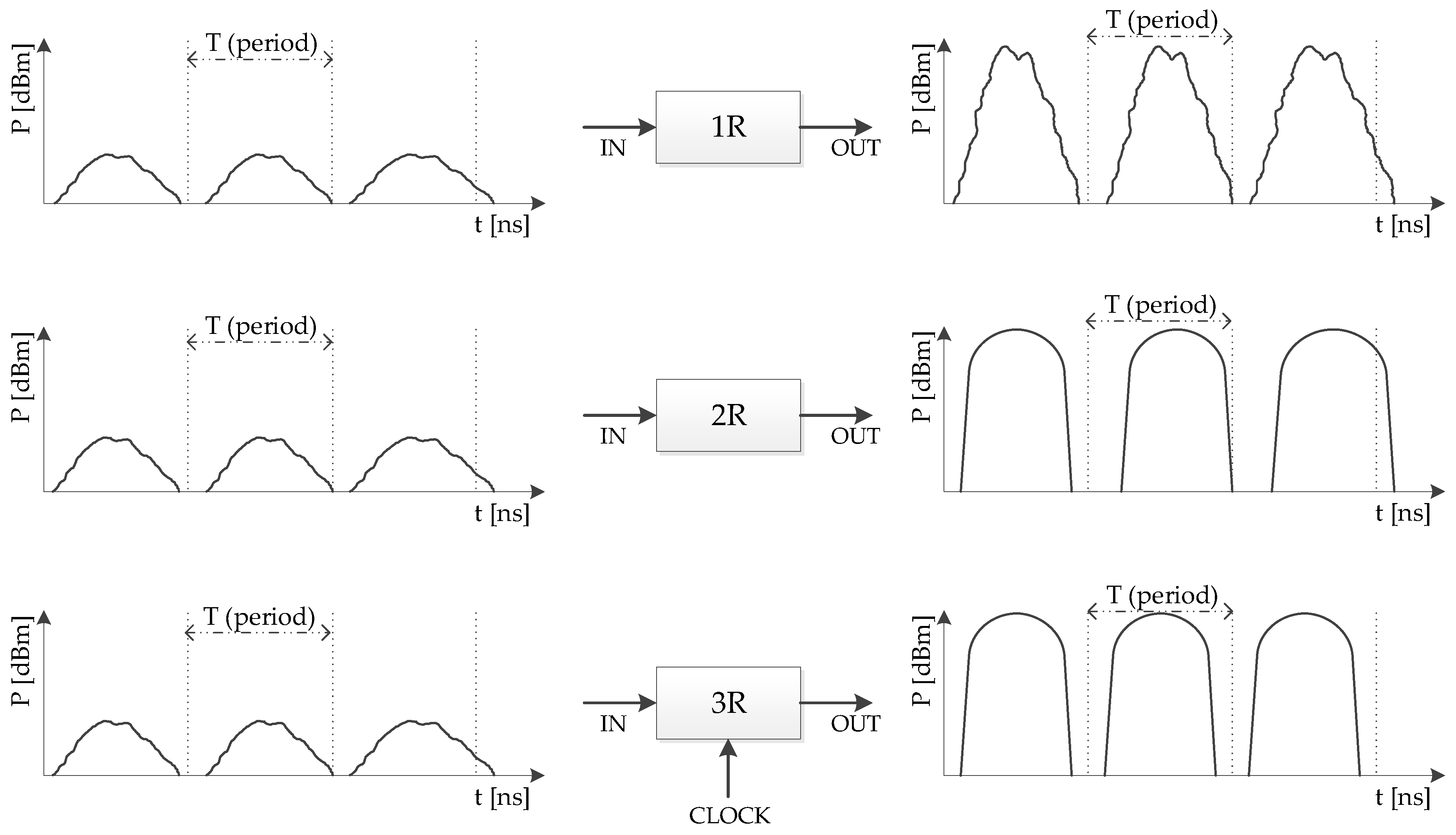
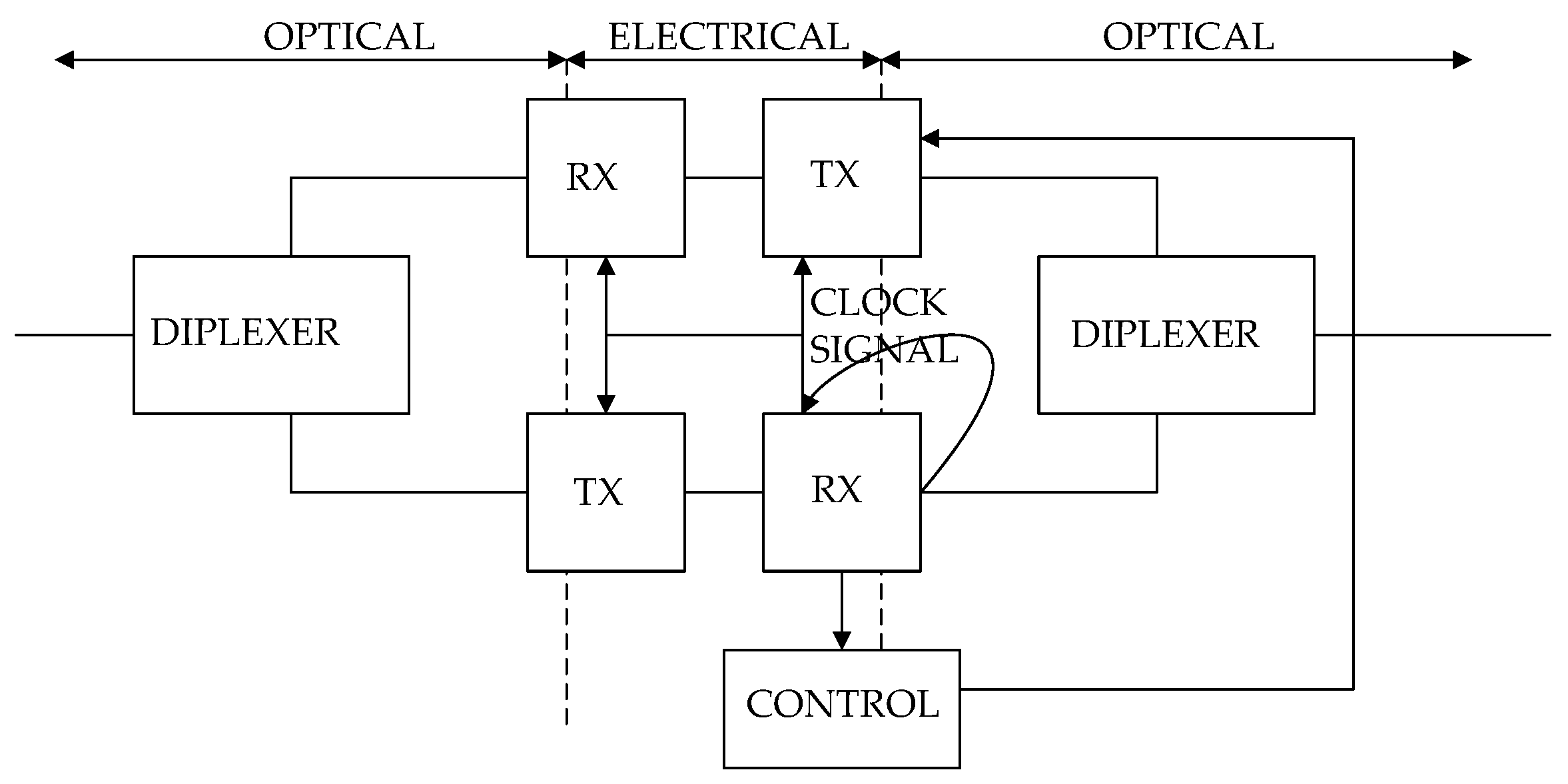
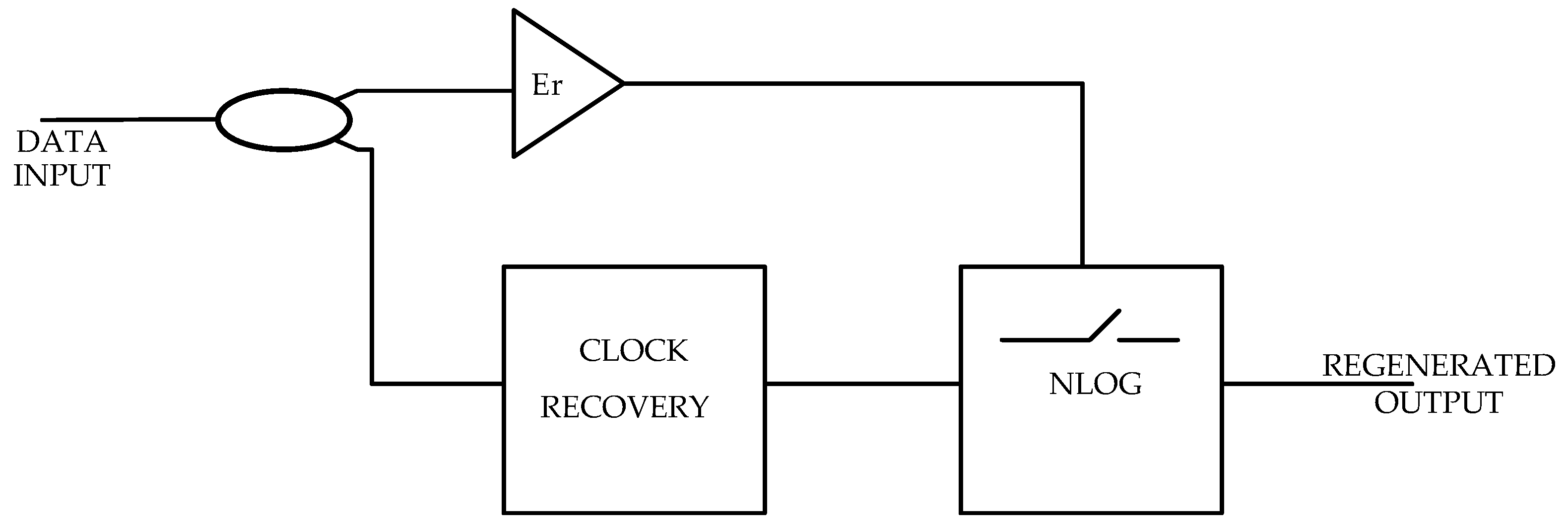

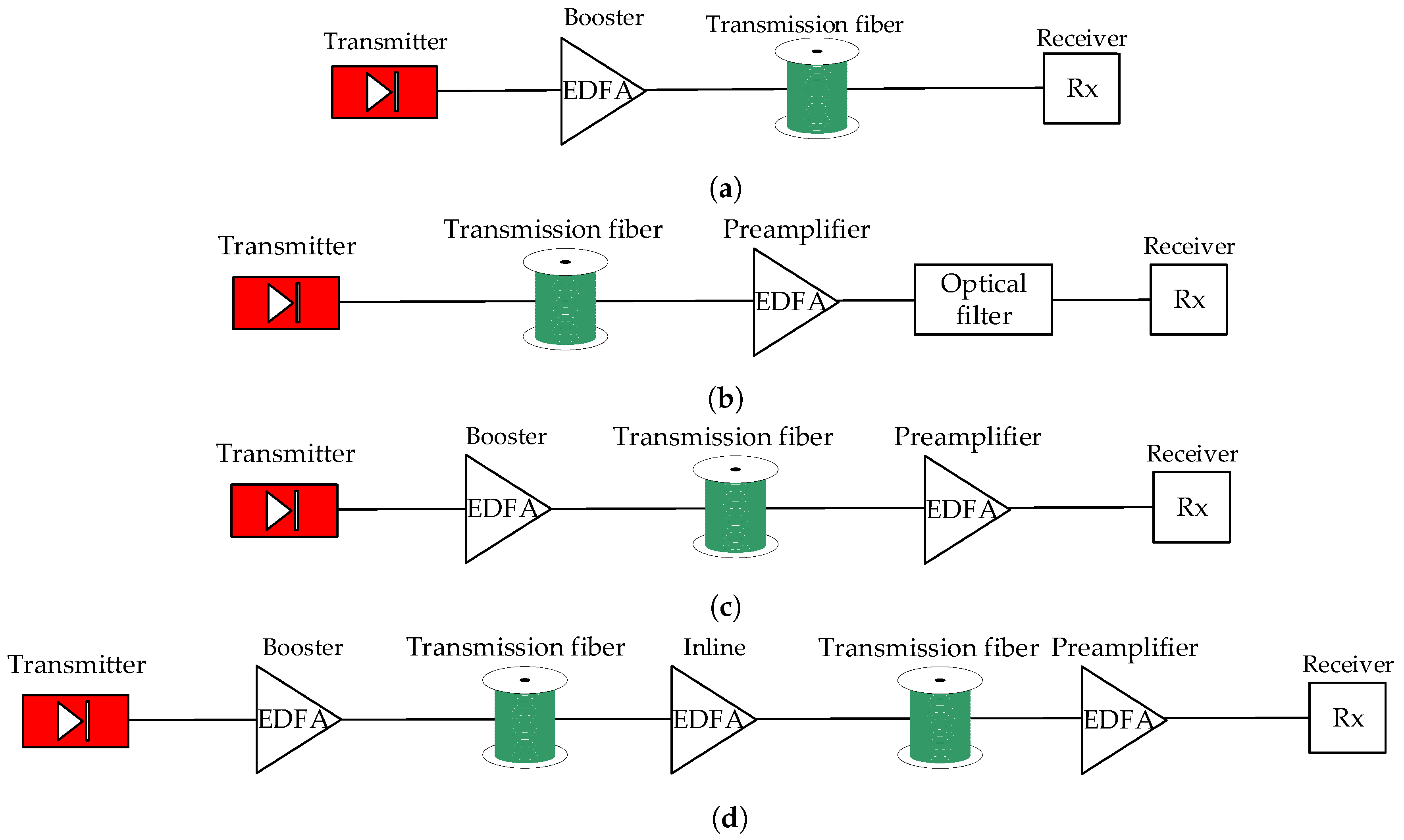



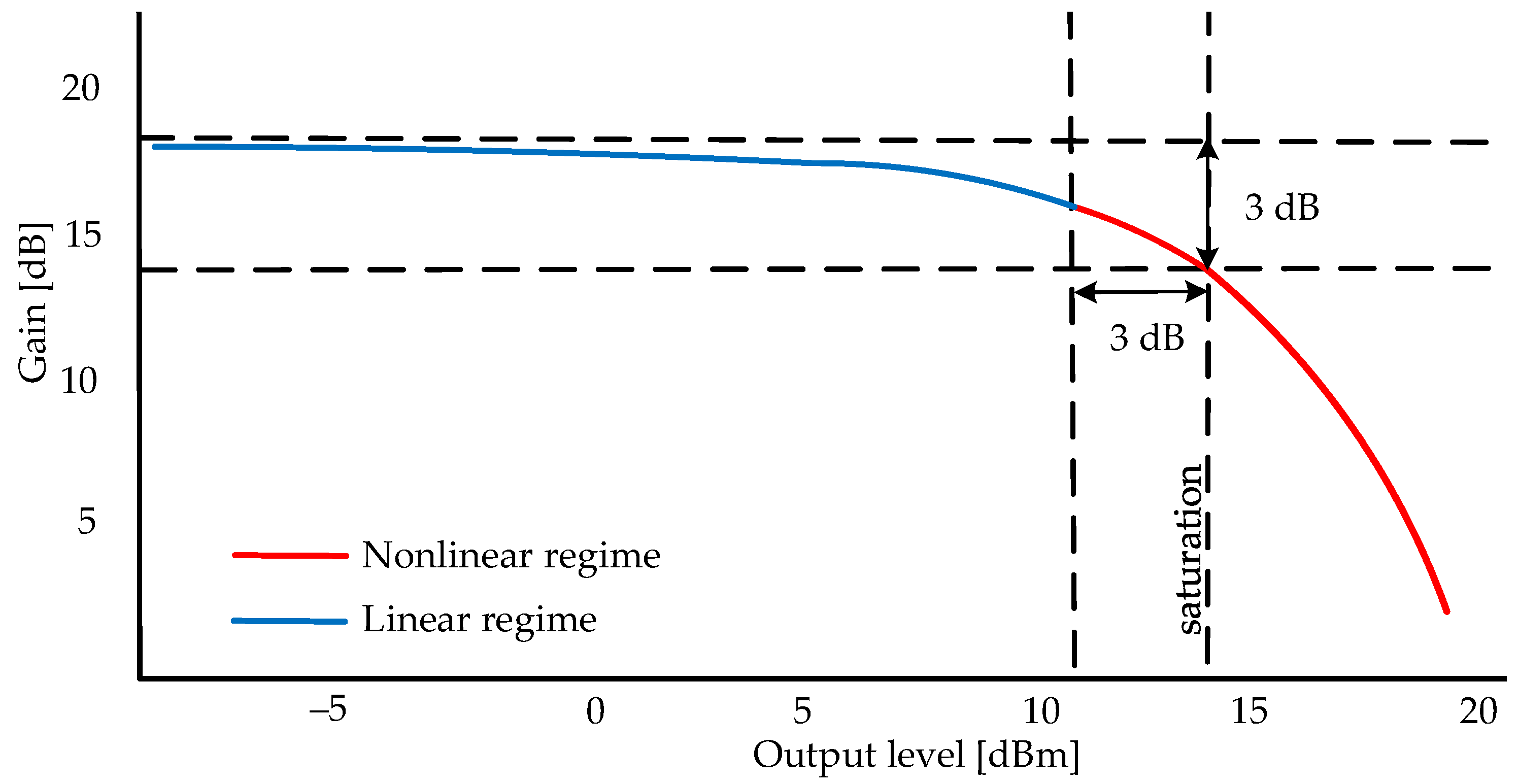
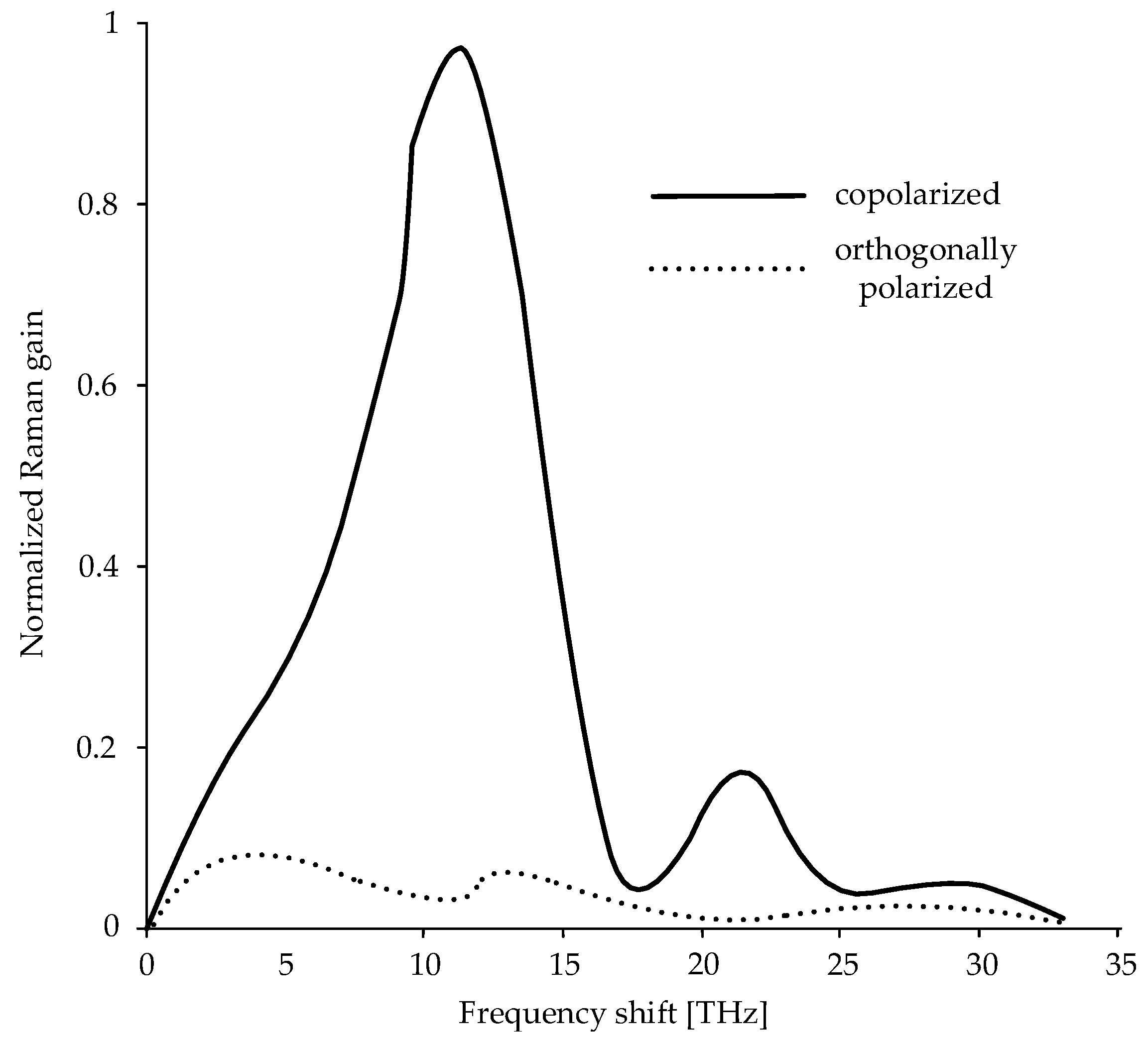
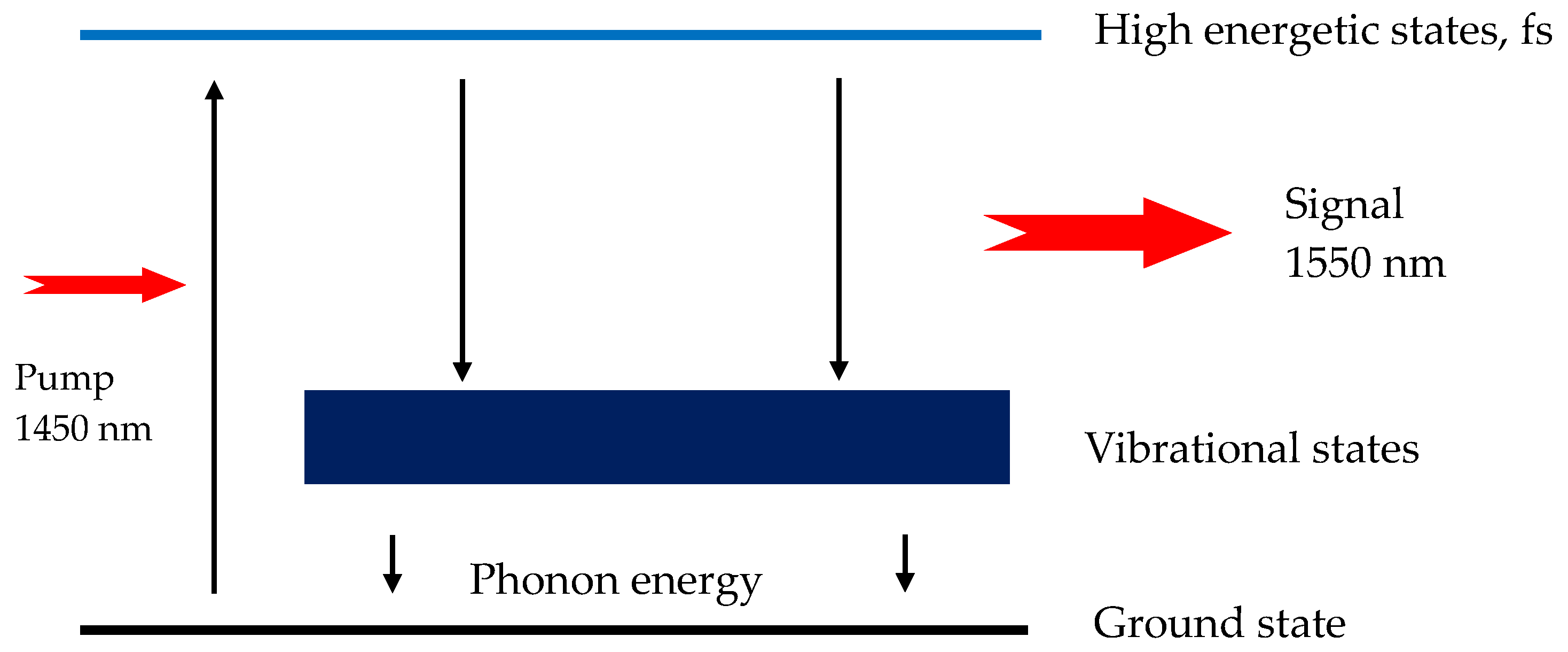

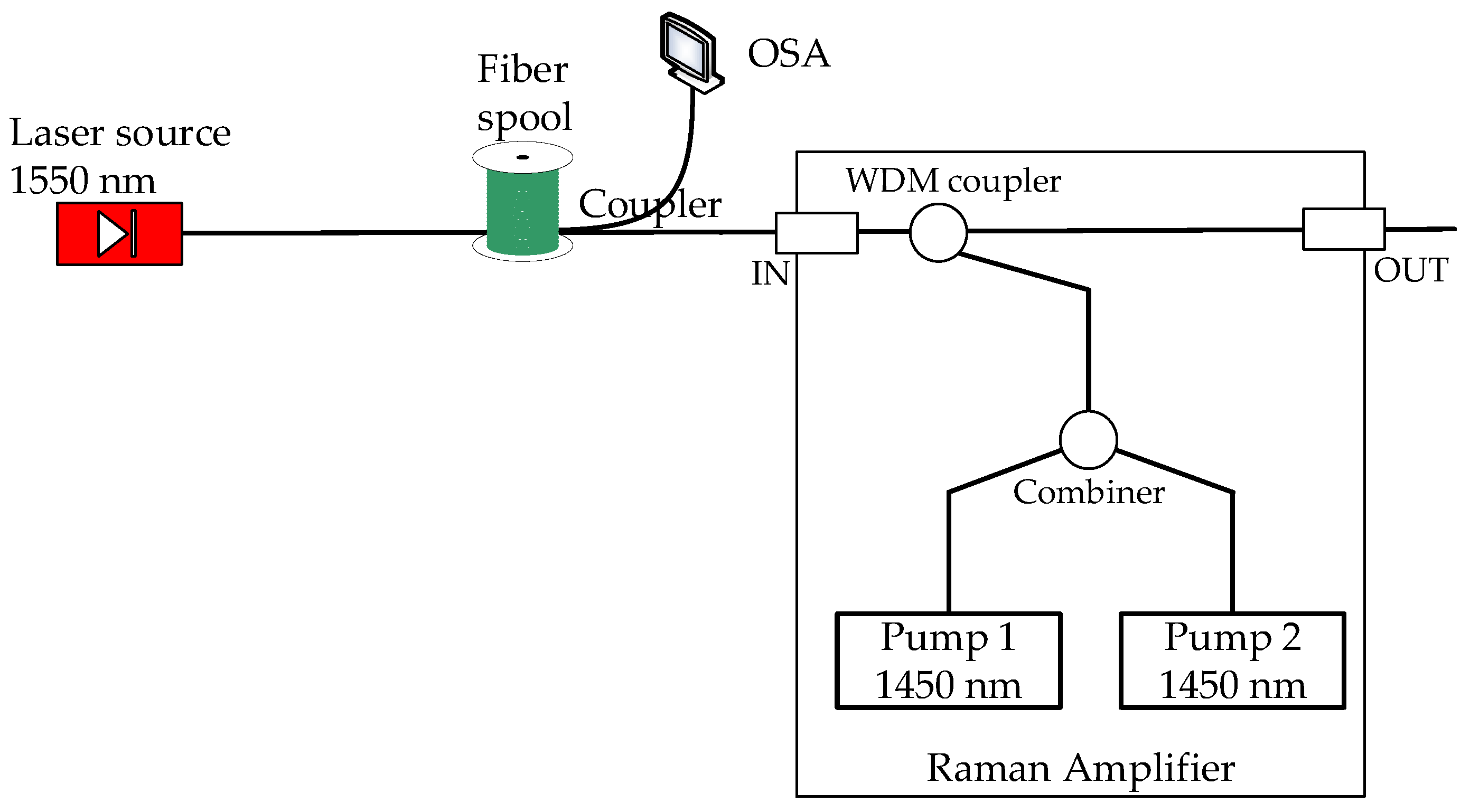
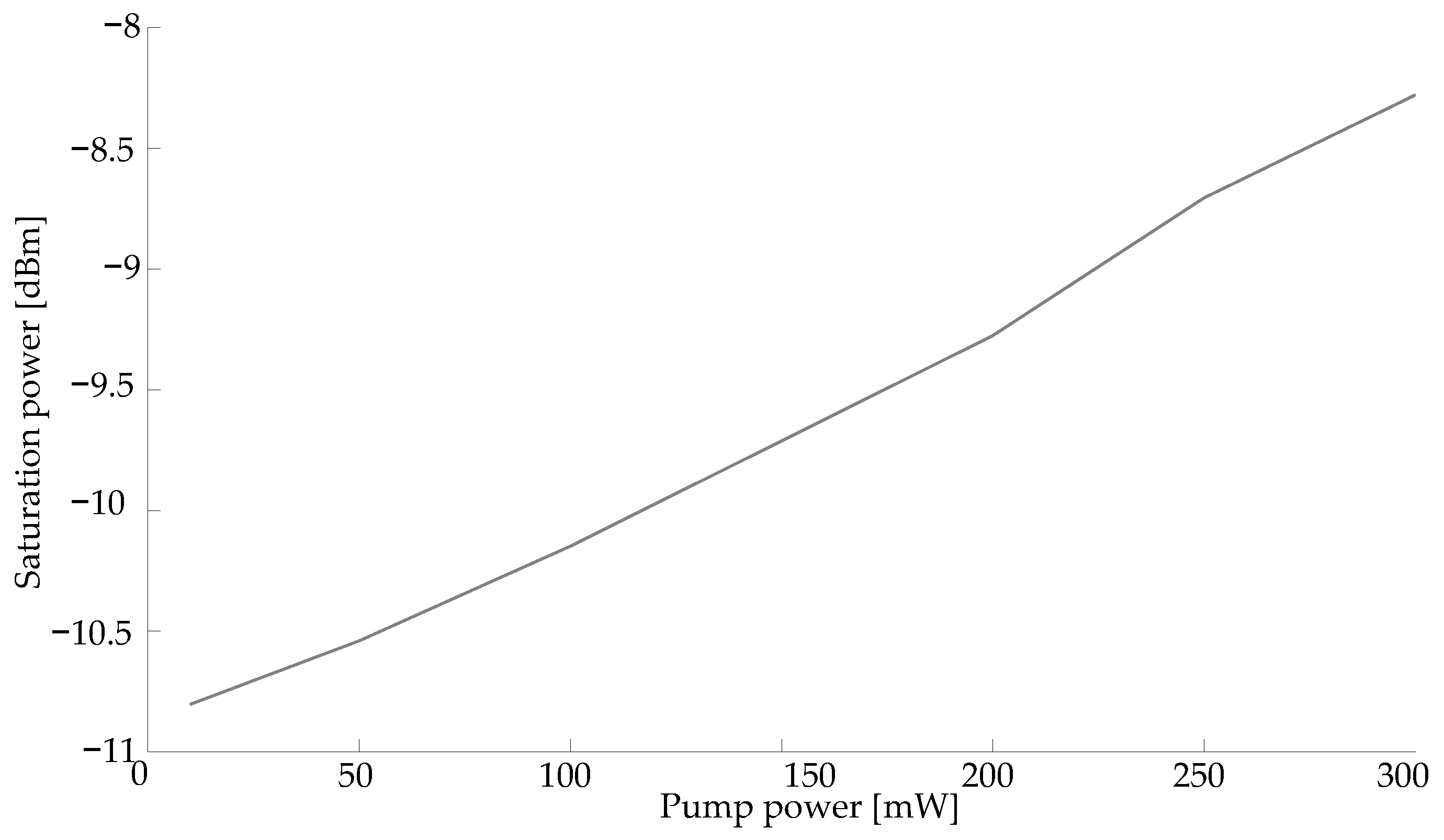
| Pump Power [mW] | Pump Wavelength [nm] | Amplified Wavelength [nm] | Amplified Saturation Power [dBm] |
|---|---|---|---|
| 10 | 1455.142 | 1552.062 | −10.803 |
| 50 | 1455.162 | 1552.060 | −10.540 |
| 100 | 1455.182 | 1552.066 | −10.148 |
| 150 | 1455.188 | 1552.066 | −9.712 |
| 200 | 1455.184 | 1552.064 | −9.276 |
| 250 | 1455.202 | 1552.064 | −8.706 |
| 300 | 1455.198 | 1552.064 | −8.280 |
| PROPERTY | EDFA | RAMAN | SOA |
|---|---|---|---|
| Gain [dB] | >40 | >30 | >30 |
| Wavelength [nm] | 1530–1625 | 1280–1650 | 1280–1650 |
| Bandwidth (3 dB) [nm] | 30–60 | up to 100 | 60 |
| Max. Saturation [dBm] | 30 | 0.75 × pump power | 18 |
| Polarization Sensitivity | No | No | Yes |
| Noise Figure [dB] | >3.5 | 5 | 8 |
| Pump power | 25 dBm | >30 dBm | <400 mA |
| Time constant [s] | 1.00 | 1.00 | 2.00 |
| Size | Rack-mounted | Bulk module | Compact |
| Switchable | No | No | Yes |
| Cost factor | Medium | High | Low |
| PROJECT | STANDARD | Reach [km] | Wavelengths | Down/Upstream [Gb/s] | End-Users |
|---|---|---|---|---|---|
| ACTS-PLANET | APON | 100 | 1 | 2.5/0.311 | 2048 |
| British Telecom | GPON | 135 | 40 | 2.5/1.25 | 2560 |
| WDM-TDM | 100 | 17 | 10/10 | 4352 | |
| PIEMAN | 100 | 32 | 10/10 | 16,384 | |
| WE-PON | GPON/EPON | 100 | 16 | 2.5/2.5 | 512 |
| SARDANA | GPON/EPON | 100 | 32 | 10/2.5 | 1024 |
© 2020 by the authors. Licensee MDPI, Basel, Switzerland. This article is an open access article distributed under the terms and conditions of the Creative Commons Attribution (CC BY) license (http://creativecommons.org/licenses/by/4.0/).
Share and Cite
Horvath, T.; Radil, J.; Munster, P.; Bao, N.-H. Optical Amplifiers for Access and Passive Optical Networks: A Tutorial. Appl. Sci. 2020, 10, 5912. https://doi.org/10.3390/app10175912
Horvath T, Radil J, Munster P, Bao N-H. Optical Amplifiers for Access and Passive Optical Networks: A Tutorial. Applied Sciences. 2020; 10(17):5912. https://doi.org/10.3390/app10175912
Chicago/Turabian StyleHorvath, Tomas, Jan Radil, Petr Munster, and Ning-Hai Bao. 2020. "Optical Amplifiers for Access and Passive Optical Networks: A Tutorial" Applied Sciences 10, no. 17: 5912. https://doi.org/10.3390/app10175912
APA StyleHorvath, T., Radil, J., Munster, P., & Bao, N.-H. (2020). Optical Amplifiers for Access and Passive Optical Networks: A Tutorial. Applied Sciences, 10(17), 5912. https://doi.org/10.3390/app10175912







